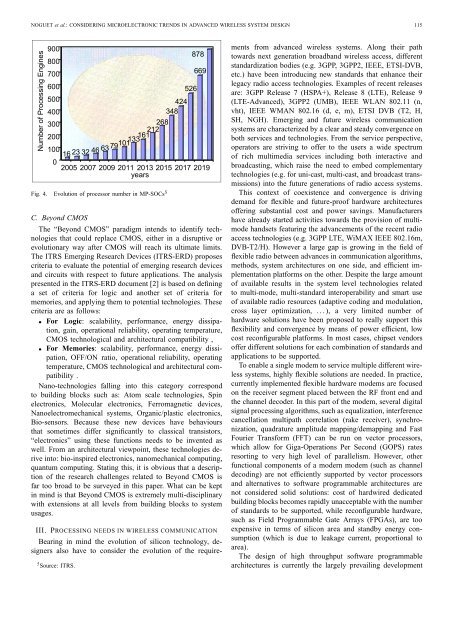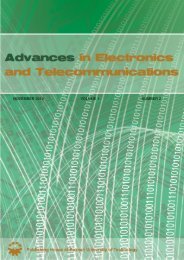channel - Advances in Electronics and Telecommunications
channel - Advances in Electronics and Telecommunications
channel - Advances in Electronics and Telecommunications
You also want an ePaper? Increase the reach of your titles
YUMPU automatically turns print PDFs into web optimized ePapers that Google loves.
NOGUET et al.: CONSIDERING MICROELECTRONIC TRENDS IN ADVANCED WIRELESS SYSTEM DESIGN 115<br />
����������������������������<br />
���<br />
���<br />
���<br />
���<br />
���<br />
���<br />
���<br />
���<br />
���<br />
�<br />
����������������������������<br />
�������������������<br />
�� �� �� �� �� �����������������<br />
���<br />
���<br />
���<br />
���<br />
���<br />
���� ���� ���� ���� ���� ���� ���� ����<br />
�����<br />
Fig. 4. Evolution of processor number <strong>in</strong> MP-SOCs 5<br />
C. Beyond CMOS<br />
The “Beyond CMOS” paradigm <strong>in</strong>tends to identify technologies<br />
that could replace CMOS, either <strong>in</strong> a disruptive or<br />
evolutionary way after CMOS will reach its ultimate limits.<br />
The ITRS Emerg<strong>in</strong>g Research Devices (ITRS-ERD) proposes<br />
criteria to evaluate the potential of emerg<strong>in</strong>g research devices<br />
<strong>and</strong> circuits with respect to future applications. The analysis<br />
presented <strong>in</strong> the ITRS-ERD document [2] is based on def<strong>in</strong><strong>in</strong>g<br />
a set of criteria for logic <strong>and</strong> another set of criteria for<br />
memories, <strong>and</strong> apply<strong>in</strong>g them to potential technologies. These<br />
criteria are as follows:<br />
• For Logic: scalability, performance, energy dissipation,<br />
ga<strong>in</strong>, operational reliability, operat<strong>in</strong>g temperature,<br />
CMOS technological <strong>and</strong> architectural compatibility ,<br />
• For Memories: scalability, performance, energy dissipation,<br />
OFF/ON ratio, operational reliability, operat<strong>in</strong>g<br />
temperature, CMOS technological <strong>and</strong> architectural compatibility<br />
.<br />
Nano-technologies fall<strong>in</strong>g <strong>in</strong>to this category correspond<br />
to build<strong>in</strong>g blocks such as: Atom scale technologies, Sp<strong>in</strong><br />
electronics, Molecular electronics, Ferromagnetic devices,<br />
Nanoelectromechanical systems, Organic/plastic electronics,<br />
Bio-sensors. Because these new devices have behaviours<br />
that sometimes differ significantly to classical transistors,<br />
“electronics” us<strong>in</strong>g these functions needs to be <strong>in</strong>vented as<br />
well. From an architectural viewpo<strong>in</strong>t, these technologies derive<br />
<strong>in</strong>to: bio-<strong>in</strong>spired electronics, nanomechanical comput<strong>in</strong>g,<br />
quantum comput<strong>in</strong>g. Stat<strong>in</strong>g this, it is obvious that a description<br />
of the research challenges related to Beyond CMOS is<br />
far too broad to be surveyed <strong>in</strong> this paper. What can be kept<br />
<strong>in</strong> m<strong>in</strong>d is that Beyond CMOS is extremely multi-discipl<strong>in</strong>ary<br />
with extensions at all levels from build<strong>in</strong>g blocks to system<br />
usages.<br />
III. PROCESSING NEEDS IN WIRELESS COMMUNICATION<br />
Bear<strong>in</strong>g <strong>in</strong> m<strong>in</strong>d the evolution of silicon technology, designers<br />
also have to consider the evolution of the require-<br />
5 Source: ITRS.<br />
ments from advanced wireless systems. Along their path<br />
towards next generation broadb<strong>and</strong> wireless access, different<br />
st<strong>and</strong>ardization bodies (e.g. 3GPP, 3GPP2, IEEE, ETSI-DVB,<br />
etc.) have been <strong>in</strong>troduc<strong>in</strong>g new st<strong>and</strong>ards that enhance their<br />
legacy radio access technologies. Examples of recent releases<br />
are: 3GPP Release 7 (HSPA+), Release 8 (LTE), Release 9<br />
(LTE-Advanced), 3GPP2 (UMB), IEEE WLAN 802.11 (n,<br />
vht), IEEE WMAN 802.16 (d, e, m), ETSI DVB (T2, H,<br />
SH, NGH). Emerg<strong>in</strong>g <strong>and</strong> future wireless communication<br />
systems are characterized by a clear <strong>and</strong> steady convergence on<br />
both services <strong>and</strong> technologies. From the service perspective,<br />
operators are striv<strong>in</strong>g to offer to the users a wide spectrum<br />
of rich multimedia services <strong>in</strong>clud<strong>in</strong>g both <strong>in</strong>teractive <strong>and</strong><br />
broadcast<strong>in</strong>g, which raise the need to embed complementary<br />
technologies (e.g. for uni-cast, multi-cast, <strong>and</strong> broadcast transmissions)<br />
<strong>in</strong>to the future generations of radio access systems.<br />
This context of coexistence <strong>and</strong> convergence is driv<strong>in</strong>g<br />
dem<strong>and</strong> for flexible <strong>and</strong> future-proof hardware architectures<br />
offer<strong>in</strong>g substantial cost <strong>and</strong> power sav<strong>in</strong>gs. Manufacturers<br />
have already started activities towards the provision of multimode<br />
h<strong>and</strong>sets featur<strong>in</strong>g the advancements of the recent radio<br />
access technologies (e.g. 3GPP LTE, WiMAX IEEE 802.16m,<br />
DVB-T2/H). However a large gap is grow<strong>in</strong>g <strong>in</strong> the field of<br />
flexible radio between advances <strong>in</strong> communication algorithms,<br />
methods, system architectures on one side, <strong>and</strong> efficient implementation<br />
platforms on the other. Despite the large amount<br />
of available results <strong>in</strong> the system level technologies related<br />
to multi-mode, multi-st<strong>and</strong>ard <strong>in</strong>teroperability <strong>and</strong> smart use<br />
of available radio resources (adaptive cod<strong>in</strong>g <strong>and</strong> modulation,<br />
cross layer optimization, . . . ), a very limited number of<br />
hardware solutions have been proposed to really support this<br />
flexibility <strong>and</strong> convergence by means of power efficient, low<br />
cost reconfigurable platforms. In most cases, chipset vendors<br />
offer different solutions for each comb<strong>in</strong>ation of st<strong>and</strong>ards <strong>and</strong><br />
applications to be supported.<br />
To enable a s<strong>in</strong>gle modem to service multiple different wireless<br />
systems, highly flexible solutions are needed. In practice,<br />
currently implemented flexible hardware modems are focused<br />
on the receiver segment placed between the RF front end <strong>and</strong><br />
the <strong>channel</strong> decoder. In this part of the modem, several digital<br />
signal process<strong>in</strong>g algorithms, such as equalization, <strong>in</strong>terference<br />
cancellation multipath correlation (rake receiver), synchronization,<br />
quadrature amplitude mapp<strong>in</strong>g/demapp<strong>in</strong>g <strong>and</strong> Fast<br />
Fourier Transform (FFT) can be run on vector processors,<br />
which allow for Giga-Operations Per Second (GOPS) rates<br />
resort<strong>in</strong>g to very high level of parallelism. However, other<br />
functional components of a modern modem (such as <strong>channel</strong><br />
decod<strong>in</strong>g) are not efficiently supported by vector processors<br />
<strong>and</strong> alternatives to software programmable architectures are<br />
not considered solid solutions: cost of hardwired dedicated<br />
build<strong>in</strong>g blocks becomes rapidly unacceptable with the number<br />
of st<strong>and</strong>ards to be supported, while reconfigurable hardware,<br />
such as Field Programmable Gate Arrays (FPGAs), are too<br />
expensive <strong>in</strong> terms of silicon area <strong>and</strong> st<strong>and</strong>by energy consumption<br />
(which is due to leakage current, proportional to<br />
area).<br />
The design of high throughput software programmable<br />
architectures is currently the largely prevail<strong>in</strong>g development







